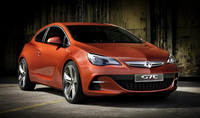GTC Paris Concept marks Vauxhall’s next bold design move

Vauxhall’s GTC Paris Concept gives the strongest hint yet to the Astra Sport Hatch’s successor and is set to cause a stir when it receives its debut at the Paris Motor Show.
Mark Adams, Vauxhall/Opel’s Vice President of Design, has described the GTC Paris as, ‘bold, pure and iconic’ in its appearance. Vauxhall has hinted that a production version will not stray far from the rakish lines of the concept, and if the GTC moniker were to be adopted, it would be the first time that a Vauxhall has been so named.
Exterior Design
At 4.46 metres, the GTC Paris offers ample space for five people, yet still maintains a svelte and sporting appearance. Adams’ team has maximised ‘tension’ in the design by limiting the amount of lines in the car’s profile, and leaving the impression that the car’s highlights and surfacing are ‘pressed’ on to the concept’s 21-inch wheels. The wheels themselves have been designed with aerodynamic efficiency in mind and feature carbon fibre inserts which enclose the centre caps.
Vauxhall’s signature blade mimics that on the Insignia and creates a fine, tense crease along the rocker panel. This combines with a second line running from the door handle to the rear of the car, emphasising both a fine undercut and broad shoulder. A third line following the silhouette of the roof is finished in fine brushed aluminium accentuating the window graphic and leads to a sharply accented integrated spoiler.
Slim, eagle-eye shaped headlamps, flanked by LED running lights with chrome surrounds dominate the front of the GTC Paris. A sharp centreline crease runs down the bonnet (a trademark styling cue from Vauxhalls of yore) and leads to a dramatically low trapezoidal grille incorporating a chrome emblem bar.
At the rear, the imposing features of the concept are enhanced with LED tail lights, showcasing a long, stretched ‘wing’ night time graphic.
Interior Design
The GTC Paris’s interior echoes the pure and iconic design of the exterior, with sweeping lines and shapes and bold use of fabric. Creating a ‘positive/negative’ effect across the front of the cabin, the driver’s seat is trimmed in red with black highlights, while the front passenger’s seat has black trim with red highlights.
Each of the front bucket seats is bespoke to the GTC Paris and has aggressively shaped contours to complement the car’s sporting intent. The GTC logo appears on each seat-back facing, along with titanium inserts that mirror the design cue seen on the front wheels’ carbon fibre inserts.
The small black leather racing steering wheel features metal inserts, while on the dashboard Vauxhall’s recurring ‘wing’ and ‘blade’ motifs can be seen. In this application, the blade appears in details like the polished chrome door grabs and the gearshift moulding. The wing design cue is evident in the wraparound instrument panel that embraces front seat occupants and arcs across the cabin into the tops of the door mouldings.
Vauxhall’s design team has used micro-fibres and leather for the seats, a textured black material for the instrument panel and plush carpeting throughout the cabin’s flooring.
Chassis & Powertrain
Underpinning the GTC Paris is a specially designed chassis with an extra-wide stance. Hinting at the car’s power potential is an updated version of Vauxhall’s FlexRide damping system, which adapts to driving styles and speeds. The new Astra’s unique compound crank / Watt’s link rear suspension is fitted to the GTC Paris, providing excellent packaging and secure, driver-focused dynamics.
The GTC Paris is powered by a 2.0-litre turbocharged four cylinder engine producing 290PS. Hinting at the power that may be achievable in a top line model, such as a VXR-badged car, the engine will be fitted with a twin-scroll turbocharger and direct fuel injection, along with double cam-phasing and twin balancer shafts. Start/Stop technology, which has just started to appear on other Vauxhall models, enhances economy and emissions without compromising performance
Power is directed to the GTC’s front wheels via a 6-speed manual gearbox, with an electronic limited slip differential ensuring that power is deployed efficiently for optimum traction.




